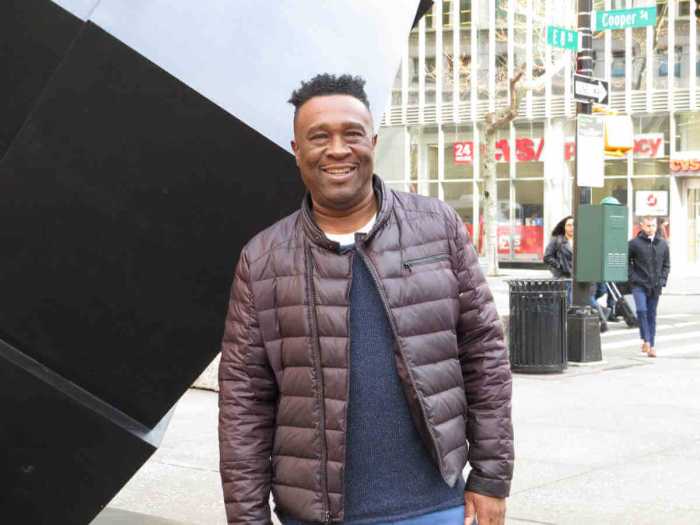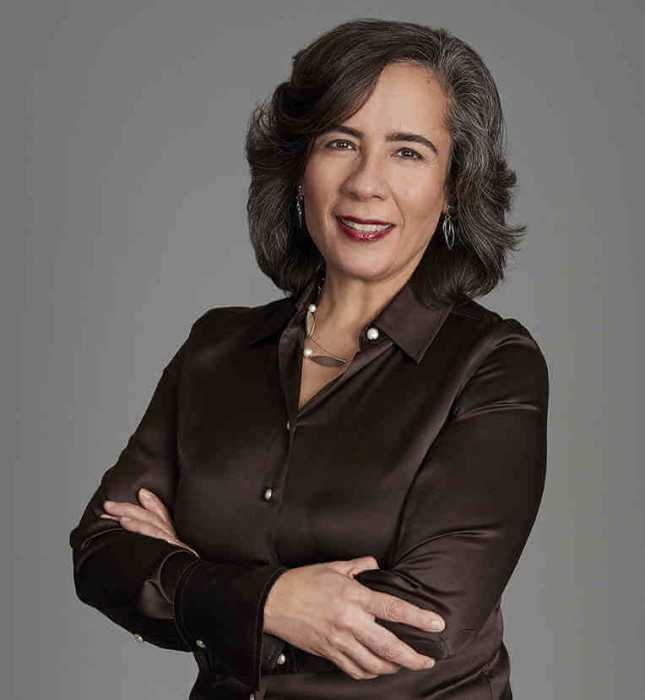A participant in the December 1 event at the Apollo Theater. | DONNA ACETO
The Apollo Theater in Harlem was packed to the rafters on the morning of December 1, but coming from the stage was not entertainment but almost three hours of passionate speeches from elected officials and advocates marking World AIDS Day. The key message was a call for an end to AIDS in New York by the year 2020 — and a United Nations official backed that up by saying that ending AIDS worldwide is within grasp by 2030.
These are not new calls, but there is patently more optimism about achieving the goals with advent of pre-exposure prophylaxis, or PrEP, and new campaigns to get at-risk people — especially young men of color who have sex with men, the most vulnerable demographic in New York — tested and, if positive, into treatment to bring their viral loads to undetectable levels and so dramatically reduce the chance they could transmit HIV.
Also in play is a higher level of commitment from the city and state — which enacted a 30 percent rent cap to stabilize the housing of poorer people with AIDS — and a blue ribbon task force appointed by Governor Andrew Cuomo to make recommendations on how to end AIDS. The movement even has a hashtag now, #EndAIDSNY2020.
Deep challenges remain, including stable housing for most vulnerable, persistent infection rates in gay, bi men
Just before the event kicked off, Tom Viola, the long-time director of Broadway Cares/ Equity Fights AIDS, one of the sponsors of the campaign, said, “It’s important to talk about the end of AIDS as a goal.”
But, he cautioned, “I don’t think that’s completely realizable,” noting how “AIDS is tied into poverty and racism and injustice.” He talked about the critical need to “reach out to people where they live and work to be tested.” Those who go on drugs to treat their HIV infection or to prevent it, Viola said, must be connected “to social services because adherence is difficult.”
Mayor Bill de Blasio, at a World AIDS Day event at Harlem's Apollo Theater, explicitly endorses Governor Andrew Cuomo's plan to end AIDS by 2020. | DONNA ACETO
Viola, who has worked on AIDS issues at BCEFA for 26 years, said he was gratified to hear his concerns about the big picture problems that fuel the AIDS epidemic echoed by many of the day’s speakers, though he acknowledged most were long enrolled in the battle against HIV.
“I like to do what is possible in front of me,” he said.
Jennifer Flynn of VOCAL-NY, one of the lead organizers of the campaign, said that since providing stable, affordable housing is one of the keys to helping people with HIV not progress to AIDS, her group wants “enhanced rental assistance” for people who are HIV-positive but do not have an official AIDS diagnosis — and are not currently covered by the 30 percent rent cap protection — “to be the number one recommendation from the governor’s task force.”
After the event, Assemblymember Dick Gottfried, a West Side Democrat who is chair of the Health Committee, said that “while I would welcome that” expansion, “it obviously has a very high price tag. It took many years to get the 30 percent rent cap for even the most severely ill. So expanding it will be difficult.”
“We think perhaps the city can do that on its own,” Flynn said, or that the governor can make it happen administratively by redefining a qualifying diagnosis for the program, which is helping an estimated 11,000 people with AIDS and could provide assistance to another 10,000 low-income people with HIV. Providing assistance to those who have not progressed to AIDS not only protects their health, but also minimizes the risk that they will be infective to their sex partners.
Gottfried is holding hearings around the state on his bill to create a single-payer health insurance system for New York State, which he thinks will be “extremely important” to the campaign to end AIDS. But he acknowledged his bill is up against an unsympathetic Republican State Senate. Even Democratic Speaker Sheldon Silver “wants to see real support for the bill in the Democratic conference” before moving the bill to the Assembly floor.
Dr. Mary Bassett, the city health commissioner. | DONNA ACETO
Asked whether the city was making use of the six mandatory AIDS lessons in all schools, Dr. Mary Bassett, the city health commissioner, had to admit that she did not know. Dr. Demetre Daskalakis, an out gay assistant health commissioner responsible for HIV programs, said that school-based education was being put forth as a major priority by those on the governor’s task force.
“Treatment makes the biggest difference,” Bassett said.
The morning rally was kicked off by Mayor Bill de Blasio, who got a standing ovation from most in the hall, and featured representatives of more than 40 AIDS organizations united for an end of AIDS, by which they mean getting new infections so low that HIV is no longer at epidemic levels.
“Change comes from the grassroots,” de Blasio said, citing advocates who pulled him aside to lobby him repeatedly on the 30 percent rent cap. He recalled his first consciousness of AIDS as an undergraduate at NYU in 1983 as a disease of “mystery and confusion” as well as his time working as a City Council colleague of the late Philip Reed, who was openly HIV-positive.
“We’ve lost 100,000 of our fellow New Yorkers to AIDS and there are 100,000 living with HIV,” de Blasio said. “We have been at the forefront of solutions,” though that certainly was not true in the early years of the epidemic under Mayor Ed Koch. New York is, however, home to many leading AIDS research programs, services pioneered by Gay Men’s Health Crisis within a year of AIDS being identified, and the fierce activists of ACT UP who first met in 1987 at the call of Larry Kramer.
The mayor touted the new NY Knows campaign targeting people 13-64, “encouraging all sexually active New Yorkers to get tested. We are going to make it easier in all five boroughs.”
Bassett hailed the drop in new HIV infections in the city to a “historic low, a 40 percent decrease from 10 years ago but not low enough. The right number is zero.” Declines in new diagnoses have comes across all demographic groups — with the notable exception of men who have sex with men.
Council Speaker Melissa Mark-Viverito, an East Harlem Democrat, used some of her time at the podium to also urge that the campaign to end AIDS be extended to her native Puerto Rico, which she said has experienced “an incredible rise” in new infections fueled by “a lack of access” to critical health services.
Councilmember Corey Johnson, an out gay and HIV-positive Chelsea Democrat who chairs the Health Committee, called HIV “a disease of inequities,” saying it will not end it “if we do not provide equal access to these interventions.” He said the “1980s definition of AIDS” that requires two opportunistic infections or a T-cell level below 200 “is out of step with current science. Now people need to get sick to qualify for support. That ain’t right!”
Dr. Demetre Daskalakis. | DONNA ACETO
Out gay State Senator Brad Hoylman, also a West Side Democrat, cited Cuomo “as the first governor to embrace PrEP” and quoted NIH’s Dr. Anthony Fauci, who heads the National Institute of Allergy and Infectious Diseases, saying “a functional cure is within our grasp.”
State Senator Daniel Squadron, a Lower Manhattan-Brooklyn Democrat, gave a passionate speech about the need to enact the Gender Expression Non-Discrimination Act, especially given the disproportionate number of transgender people at risk for HIV. Afterwards, he acknowledged, “We’re a long way from getting it passed” in his Republican-controlled house.
Daskalakis said that every person with HIV, every service provider, and every counselor “is an activist in the effort to keep all of New York undetectable.” While promoting PrEP, he is not abandoning condoms. “The Department of Health has wrapped this city in latex,” he said. PrEP, used consistently, reduces the chance for an HIV infection “96 percent” he said.
Julie Lynn, 48, talked about having grown up in the “Fear Generation” regarding AIDS.
“HIV stole my youth,” she said, saying she went through “30 years of fear” over the peril of sexual encounters. She has turned to PrEP for peace of mind, but will not abandon condoms. “I’m finally in the position to be the sexual person I wanted to be at 18,” Lynn said.
“I am tired of hearing that that New York City is the epicenter of HIV,” Daskalakis said. “”New York City is going to be the epicenter of ending HIV.”
Keith Holder of Housing Works said he was “a 25-year survivor” and credited the group with “taking away the stigma of being HIV-positive.” He had a time in his life “where I slept on the A train for six months,” but has pulled through. “I’m so happy to be undetectable now,” he said.
Simon Bland, director of the UNAIDS office in New York, said “we’ve made incredible progress” worldwide, though “we have lost 35 million to this dreadful disease and have 36 million living with it. One and a half million die each year.” Still, he said, “2013 was a tipping point because there is more access to treatment for those becoming newly infected. We have the tools. This is no time for complacency. We can end AIDS by 2030.”






































